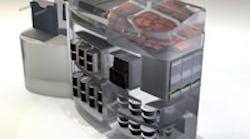Eastman Chemical Co. gives students a chance to display their talents.
Indeed, the Kingsport, Tenn.-based manufacturer of more than 1,200 chemicals, fibers and plastics worldwide recently teamed with the Department of Industrial Design at Auburn University, Auburn, Ala., to host a retail design program in which students researched real-world design challenges and developed cutting-edge displays. The goal: Get students enthused about Eastman Chemical products in hopes that they will remember the positive experience when they are a part of the workforce in the near future.
The students’ final designs included displays for DVDs, coffee, linens and an overhead “skyline” fixture for self check-out kiosks. The semester-long project was documented by the students in a dedicated blog (http://eastmanau2008.blogspot.com), which features their research findings and final concepts and serves as a resource to the larger design community.
Students experimented with the properties and design flexibility of Eastman Spectar copolyester. Guided by Eastman’s engineers, they learned about thermoforming, heating, freezing, bending and decorating Spectar.
Eastman Chemical provided students
an opportunity to design products using
the company's Spectar polymers.
“The students of today are the designers of tomorrow, and they will shape the future of innovative retail environments,” says Adia Delaney-Jackson, Market Development Manager for Visual Merchandising at Eastman Chemical Co. “Providing students the opportunity to exercise their creativity with Spectar represents our commitment to sharing our material expertise with designers who play an increasingly vital role to creating cutting edge retail environments.”
Adding to its polymers lineup, Eastman recently launched a family of Tritan medical-grade polymers for the medical device industry.
Medical grades of Eastman Tritan copolyester provide lipid and chemical resistance; higher heat stability; easy processing; long-term clarity; added durability and toughness; and are made without bisphenol-A (BPA) or halogens.
“Eastman Chemical Co. has supplied a wide range of materials to medical customers for more than 65 years,” said Helen Sirett, medical business segment manager, Eastman Chemical Co. “Based upon our industry understanding, we are confident that the launch of Eastman Tritan copolyester will provide customers with a high-quality product that provides processing and performance advantages over heritage copolyesters, polycarbonates and acrylics.”
The new medical grades of Eastman Tritan copolyester are said to be well-suited for a variety of medical-device applications that demand chemical resistance, clarity, hydrolytic stability and retention of properties after gamma, electron beam (E-beam) and ethylene oxide (EtO) sterilization. Additionally, Tritan provides protection against the negative effects of common materials that can lead to environmental stress cracking and deterioration in medical environments. Possible application options include IV system components, respiratory devices, blood therapy devices, and infant-care products.
In fact, Pembroke, Mass.-based Hawaii Medical recently introduced its Gumdrop Pacifier made with Eastman Tritan copolyester.
“To meet the demand for lightweight, low-profile silicone pacifiers, we needed a material that had design flexibility and could be processed easily to fit the requirements for our preemie and newborn pacifier product line,” said Read McCarty, president and CEO of Hawaii Medical.
The GumDrop pacifier is designed with a rigid plastic guard, made from the new copolyester, and is completely overmolded with silicone. The overmolding process creates a single-body construction that won’t separate.
While Eastman continues to move forward with its product launches, it still must address the current economic conditions. The company announced full-year 2008 results. As expected, the company reported losses. Eastman Chemical posted a loss of $0.03 per diluted share for fourth quarter 2008 versus earnings from continuing operations of $1.25 per diluted share for fourth quarter 2007.
“The current global recession has resulted in an unprecedented decline in demand and negatively impacted our fourth-quarter results," said Brian Ferguson, chairman and CEO. "The strategic actions we have taken over the last five years, as well as the cost reduction measures we recently announced, position us to weather the current storm and rebound decisively when demand recovers.”
By segment, the Coatings, Adhesives, Specialty Polymers and Inks sales revenue declined 14% from fourth quarter 2007 to fourth quarter 2008 as a result of lower sales volume.
However, year-on-year results increased by 5% due to higher selling prices. The higher selling prices were mainly the result of efforts to offset higher raw material and energy costs.
Regarding the company’s Performance Chemicals and Intermediates segment, sales revenue declined 27% from fourth quarter 2007 to fourth quarter 2008, due primarily to lower sales volume.
However, year-on-year results showed sales revenue increased 3% due to higher selling prices.
Commenting on the outlook for first quarter and full-year 2009, Ferguson said, “While we expect the weak demand in fourth quarter 2008 to continue in first quarter 2009, our capacity utilization likely reached its lowest point in December. We anticipate that our capacity utilization will improve through the first quarter due to a modest increase in demand, and on average be slightly higher in first quarter 2009 compared with fourth quarter 2008. As a result, we expect our first quarter earnings per share to be slightly higher than fourth quarter earnings per share excluding gains and charges related to strategic and cost cutting actions and other income in fourth quarter 2008.”
Eastman Chemical is a Chemical Processing 50 company.
To visit the Eastman Chemical Co. CP 50 profile page, visit: http://www.chemicalprocessing.com/cp50/2008/eastman_chemical.html.
To return the to the CP 50 list, visit: http://www.chemicalprocessing.com/cp50/index.html.


